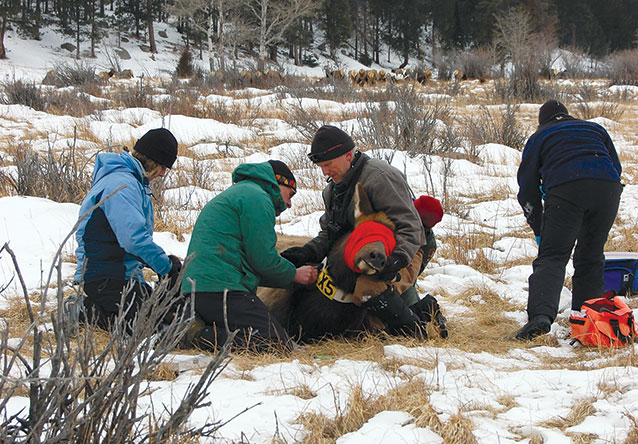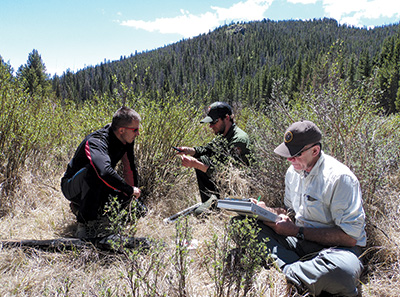The need to cull is evaluated annually based on several factors, including population data, predictive modeling ..., projected hunter harvest outside the park, and potential culling scenarios in the park, including no reduction.
Key words: elk, population modeling, resource management, restoration, vegetation monitoring
OVER THE PAST CENTURY elk (Cervus elaphus) management in Rocky Mountain National Park has evolved along with NPS policy, social values, and an improved understanding of the role of elk in the ecosystem. Science has played an important part in shaping management approaches through the application of monitoring and research (Monello et al. 2006).
Early settlers indicated that elk were once abundant in the Estes Valley, but by the 1880s they were locally extirpated by market hunting. Elk were translocated from Yellowstone National Park by the Estes Park Protective and Improvement Association and the U.S. Forest Service to reestablish a population in 1913–1914, prior to park establishment. The elk population grew quickly in the absence of hunting by humans and predation by both gray wolves (Canis lupus) and grizzly bears (Ursus arctos horribilis), significant predators that had been extirpated. Studies conducted in the 1930s and 1940s found shrubs and aspen on the elk winter range were heavily browsed. Range conditions were deteriorating, motivating the park to reduce the population through direct control by shooting or relocating elk from 1944 to 1968. After 1968, as social values changed and support for control programs declined, direct control was replaced by “natural regulation,” a hands-off approach that allowed elk numbers to increase to ecological carrying capacity (Wright 1992; Monello et al. 2006). The park and its partners recognized, however, that hunting outside the park was necessary to help fulfill the role of extirpated predators. Monitoring through the 1980s documented an increase in the elk population, but suggested that the use of key range areas had stabilized; thus there was no need for direct control at that time (Stevens 1980).
By the early 1990s, elk had not been actively managed in the park in more than two decades. Conflicts between people and elk increased and habitat conditions declined, causing managers to question the appropriate population size and management approach. Scientists conducted more than 40 studies to better understand the elk population, its influence on other resources, and long-term ecosystem sustainability. This work included a joint NPS–USGS research initiative that focused on collecting key data to provide a strong scientific basis for management planning (Singer and Zeigenfuss 2002). Research results suggested that a combination of extirpation of predators, land and water development, and past land uses contributed to (1) an overabundant, highly concentrated, and less migratory elk population; (2) declines in beaver (Castor canadensis); (3) hydrologic changes; and (4) loss of aspen (Populus tremuloides) and willow (Salix spp.) habitats that supported high biodiversity. After population control ended, the winter elk population initially increased, gradually stabilized, and then fluctuated around an estimated carrying capacity of 1,000 (Lubow et al. 2002). Ecosystem modeling predicted that under natural conditions with wolves present the winter population would fluctuate between 200 and 800, allowing willow and aspen to persist (Coughenour 2002).
Elk and vegetation management plan
The robust body of research allowed the park to lead an interagency team in developing an Elk and Vegetation Management Plan (USDOI 2007) from 2004 to 2007. Elk that use the park are part of a regional migratory population, making interagency cooperation essential. Ecosystem modeling was used to evaluate a range of management alternatives by predicting the habitat conditions and elk population size expected to result from each alternative if it were selected. Social science research found strong public support for taking action to reduce the population and restore vegetation, but no agreement on the approach (Stewart et al. 2004). The final plan called for using a combination of conservation tools, including temporarily fencing up to 600 acres (243 ha) of habitat, culling, and vegetation restoration methods to restore a natural range of variability in the elk population and vegetation conditions.

NPS/John Cordsen
Implementation of the 20-year plan began in 2008, and science has continued to inform the park’s adaptive management strategies. To begin restoration, temporary elk exclosure fences were constructed to protect approximately 228 acres (92 ha) of aspen and willow habitat from browsing. A total of 130 female elk were culled during winter in 2009–2011 to achieve and maintain a low-end population objective. Of these, 79 elk were used for research to develop a live test for chronic wasting disease in elk and to test a fertility control agent for potential future use (fig. 1). The need to cull is evaluated annually based on several factors, including population data, predictive modeling that estimates expected population size, projected hunter harvest outside the park, and potential culling scenarios in the park, including no reduction. In the past four years culling has not been needed.

NPS/Therese Johnson
An interagency workshop was recently held to support adaptive management by summarizing current science and evaluating progress toward management objectives. Vegetation monitoring from 2008 to 2013 found that average willow height increased 29% and willow cover increased 20% across the winter range, with progress made primarily inside fences (fig. 2). Distribution of aspen stem sizes reflected a shift toward recruitment of younger trees, and sapling recruitment increased from 13% to 26% of sampled sites, again nearly all inside fences (Zeigenfuss and Johnson in press). Elk population monitoring found that an elk range shift occurred in 2002–2012 with more elk wintering outside the park, and that since plan implementation began in 2008, elk winter range densities have decreased and migration off the winter range during summer has increased (unpublished data from Colorado Parks and Wildlife, the National Park Service, and the U.S. Geological Survey). A five-year declining trend in the park winter population continued during 2013–2014, with an estimated average of 185 elk using the park (Hobbs 2014).
Research and monitoring continue to provide a strong scientific basis for management decisions and interagency collaboration as the park enters the next phase of implementation. We used results from 2013–2014 research that evaluated experimental willow establishment using cuttings and seeding (Kaczynski and Cooper 2014) to guide broader-scale willow planting in 2015. Current collaborative work among the National Park Service, Colorado Parks and Wildlife, and Colorado State University is investigating many dimensions of elk management, including (1) potential population-level effects of chronic wasting disease, (2) adult female survival rates and mortality sources, (3) landscape-scale elk movements, (4) substantial changes in regional elk distribution, (5) frequency of cross-boundary movements, and (6) further development of population survey methods. Ultimately, maintaining the critical link between science and adaptive management will play a key role in promoting long-term ecosystem health and sustainability.
Literature cited
Coughenour, M. B. 2002. Elk in the Rocky Mountain National Park ecosystem: A model-based assessment. Unpublished report to USGS Biological Resources Division and U.S. National Park Service, Natural Resource Ecology Laboratory, Colorado State University, Fort Collins, Colorado, USA.
Hobbs, N. T. 2014. Annual report: Modeling in support of adaptive management of the Rocky Mountain National Park elk population. Report to the National Park Service, Natural Resource Ecology Laboratory, Colorado State University, Fort Collins, Colorado, USA.
Kaczynski, K. M., and D. J. Cooper. 2014. Willow restoration in Moraine Park—2014 summary. Report to the National Park Service, Colorado State University; Department of Forest, Rangeland, and Watershed Stewardship; Fort Collins, Colorado, USA.
Lubow, B. C., F. J. Singer, T. L. Johnson, and D. C. Bowden. 2002. Dynamics of interacting elk populations within and adjacent to Rocky Mountain National Park. Journal of Wildlife Management 66:757–775.
Monello, R. J., T. L. Johnson, and R. G. Wright. 2006. The ecological role of elk in Rocky Mountain National Park. Unpublished report, Rocky Mountain National Park, Estes Park, Colorado, USA.
Singer, F. J., and L. C. Zeigenfuss, compilers. 2002. Ecological evaluation of the abundance and effects of elk herbivory in Rocky Mountain National Park, Colorado, 1994–1999. U.S. Geological Survey Open File Report 02-208, Fort Collins Science Center, Fort Collins, Colorado, USA.
Stevens, D. R. 1980. The deer and elk of Rocky Mountain National Park: A 10-year study. National Park Service Report ROMO-N-13, Rocky Mountain National Park, Estes Park, Colorado, USA.
Stewart, S. C., P. J. Fix, and M. J. Manfredo. 2004. Public perceptions of elk and vegetation management in Rocky Mountain National Park, Colorado. Project Report No. 56 for Rocky Mountain National Park, Human Dimensions in Natural Resources Unit, Colorado State University, Fort Collins, Colorado, USA.
U.S. Department of the Interior (USDOI). 2007. Final environmental impact statement/elk and vegetation management plan. Rocky Mountain National Park, Colorado. National Park Service, Washington, D.C., USA.
Wright, R. G. 1992. Wildlife research and management in the national parks. University of Illinois Press, Chicago, Illinois, USA.
Zeigenfuss L. C., and T. L. Johnson. 2015. Monitoring of vegetation response to elk population and habitat management in Rocky Mountain National Park, 2008–1204. U.S. Geological Survey Open-File Report 2015–2016, Fort Collins Science Center, Fort Collins, Colorado, USA. doi:10.3133/ofr20151216.
About the authors
Therese L. Johnson is the director of the NPS Continental Divide Research Learning Center at Rocky Mountain National Park. Linda C. Zeigenfuss is an ecologist with the U.S. Geological Survey Fort Collins Science Center. N. Thompson Hobbs is a senior research scientist with the Natural Resource Ecology Laboratory at Colorado State University. John A. Mack is the branch chief for Natural Resources with Rocky Mountain National Park.
Download: PDF of this article
This article published
Online: 6 May 2016; In print: 25 March 2016
URL
https://www.nps.gov/ParkScience/articles/parkscience32_2_70-72_johnson_et_al_3841.htm
Suggested citation
Johnson, T. L., L. C. Zeigenfuss, N. Thompson, and J. A. Mack. 2016. The role of science through a century of elk and habitat management at Rocky Mountain National Park. Park Science 32(2):70–72
This page updated
5 May 2016
Site navigation
• Back to Volume 32, Number 2
• Back to Park Science home page
Last updated: March 21, 2021
